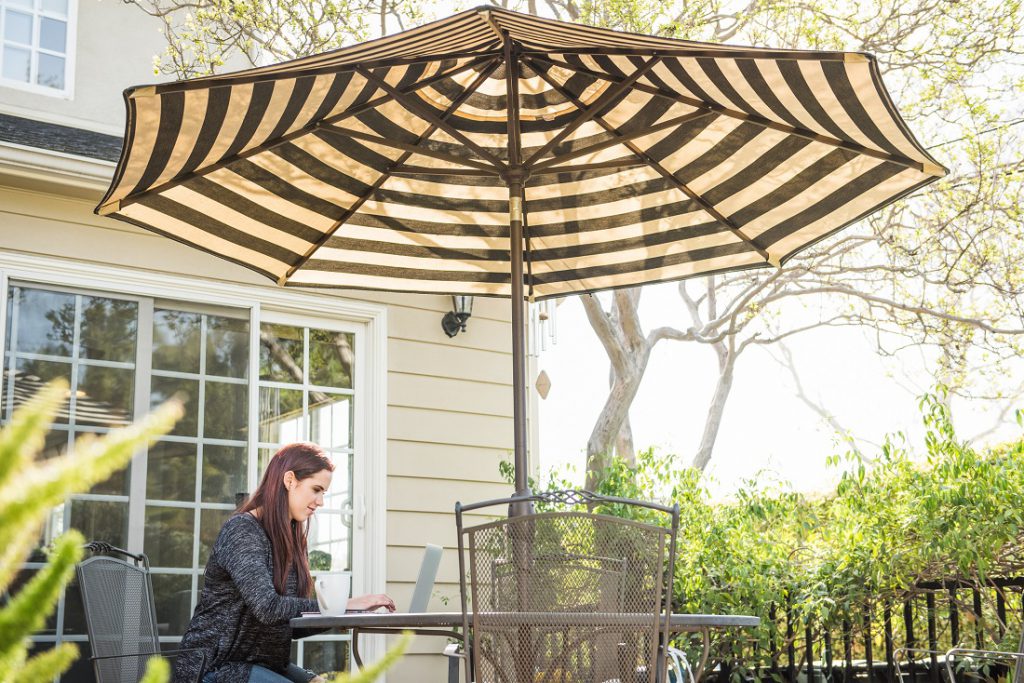Jane Austen was definitely on to something when she wrote, “To sit in the shade on a fine day and look upon verdure is the most perfect refreshment.” There are few things better than resting under a tree or lounging on a breezy porch on a hot day. Not only does shade give you a reprieve from the heat, but it can also help to protect you from the sun’s harmful ultraviolet (UV) rays, which can cause skin damage and lead to skin cancer.
Shade sounds simple enough. (Find a tree, sit under it — what’s so hard about that?) When exploring sun protection, however, it’s not as clear-cut as you may think: Not all shade structures are the same, and the level of sun protection offered can vary a great deal. Next time you’re thinking shade, consider the following:
Shade Isn’t Enough
Have you ever sat on the beach for the entire day with an umbrella overhead? If you have, you probably had to reposition the umbrella multiple times to make sure you were still getting adequate coverage from the sun’s rays as it moves across the sky. The sun doesn’t stay still for long, and that can pose a unique challenge for many shade structures. Trees and awnings may provide some coverage when the sun is directly overhead, but less as it rises and sets, allowing the sun’s rays to hit you from different angles.
No shade structure can completely shield you from indirect exposure to UV radiation, the type that occurs when UV rays bounce off of reflective surfaces like water, sand, concrete and even snow. Under a beach umbrella, you may be receiving less direct UV radiation, but you’re still surrounded by sand that is reflecting UV rays on all sides of your beach chair or blanket. Because of these limitations, shade isn’t enough to protect you. In fact, it’s just one component of a complete sun protection strategy that includes daily use of a broad-spectrum sunscreen with an SPF of 15+ (30+ if you’re spending extended time outdoors), UV-protective clothing, a wide-brimmed hat and UV-blocking sunglasses.
Not All Shade Is Created Equal
Factors that determine how effective a shade structure is at providing sun protection include:
Size of the structure: Larger shaded areas, such as a wraparound porch or large awning, provide more protection than small ones, like an umbrella.
Fabric: When looking for a new beach umbrella or awning, be sure to look at the ultraviolet protection factor (UPF) on the label. Any fabric used in a shade structure should have a UPF of 30 or higher. Look for our trusted Seal of Recommendation as you consider your options.
Density of the shade protection: A porch or lanai with a solid roof provides more consistent sun protection from above than the leafy branches of a tree, which shift in the breeze and allow some sun to penetrate.
Proximity to buildings or other shade structures: A single tree is going to provide less UV protection than a tree surrounded by other trees in a dense forest. Similarly, a shady side of the street in a city provides more sun protection when the buildings are tall and tightly packed. This is because surrounding structures can help to block more of the sky, lessening both direct and indirect exposure.
Side Protection: As described above, UV rays can reach your skin by bouncing off reflective surfaces. Shade structures with side protection, like those nifty beach tents that have become popular in recent years, provide better protection than structures without any walls or side draping.
We understand that you’re not always the one purchasing the shade structure you find yourself tucked under during a sunny day. In those cases, a good rule of thumb is to take note of the amount of open sky you can see from under the shade structure. The less sky you can see, the better (but a little verdure is always welcome).




